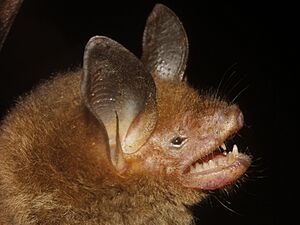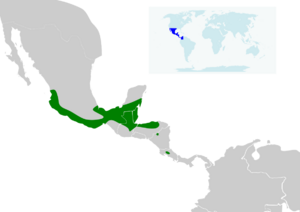Van Gelder's bat facts for kids
Quick facts for kids Van Gelder's bat |
|
|---|---|
 |
|
| Conservation status | |
| Scientific classification | |
| Genus: |
Bauerus
|
| Species: |
dubiaquercus
|
 |
|
The Van Gelder's bat (Bauerus dubiaquercus) is a special type of bat. It is also known as the Van Gelder's big-eared bat because of its large ears. This bat belongs to a group called vesper bats. They are part of the Vespertilionidae family.
You can find this bat in parts of Central America. Its home includes countries like Belize, Costa Rica, Honduras, and Mexico. Van Gelder's bats live in forests. They can be found from sea level up to high mountains. These bats eat only insects. They are active around dawn and dusk. Sadly, their homes are shrinking because of deforestation.
Contents
What is Van Gelder's Bat?
Van Gelder's bat is a unique animal. It is the only species in its genus (a group of closely related animals). This bat is related to the pallid bat. Both are part of a larger bat family. Van Gelder's bat is an insectivorous animal. This means it eats insects. It hunts for food when the sun is setting or rising.
How Van Gelder's Bat Got Its Name
The Van Gelder's bat was first found by Richard Van Gelder. He was a scientist who studied mammals. He worked at the American Museum of Natural History. The bat was collected during an expedition in 1957. This trip went to the Tres Maria Islands, south of Baja California.
Two people found the bat: Richard Zweifel and Oakes Plimpton. Richard Van Gelder named the bat dubiaquercus. This name honors the two collectors. Dubia means "doubt" in Latin. This is like "zweifel" in German. Quercus means "oak" in Latin.
Where Van Gelder's Bat Lives
Van Gelder's bat lives in Central America. Its range covers several countries. These include Belize, Costa Rica, El Salvador, Guatemala, Honduras, Mexico, and Nicaragua.
These bats live in different kinds of places. They have been seen from about 100 meters (328 feet) above sea level. They can also live as high as 2,300 meters (7,546 feet) up in the mountains. However, they usually stay below 1,300 meters (4,265 feet).
Protecting Van Gelder's Bat
As of 2018, the IUCN lists Van Gelder's bat as a near-threatened species. This means it might become endangered soon. There are a few reasons for this. The bat is not common in many places where it lives. Its numbers are going down. Also, the places where it lives are very delicate.
The biggest threat to Van Gelder's bat is deforestation. This is when forests are cut down. When forests are removed, the bats lose their homes and places to find food. Protecting these forests is important to help the bats survive.


